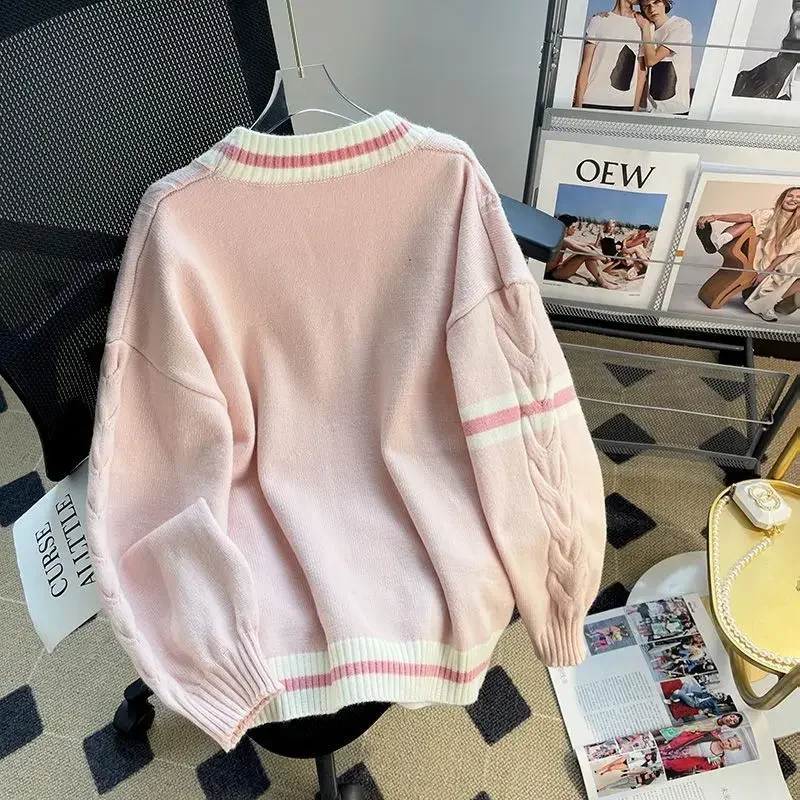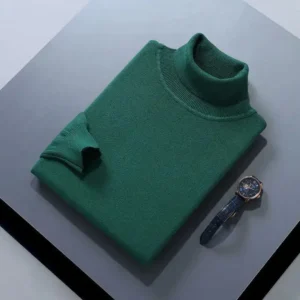Introduction to Cashmere Gauge and Its Importance
Cashmere stands as one of the world’s most luxurious natural fibers, celebrated for its exceptional softness, surprising warmth despite its lightweight nature, and beautiful drape. When shopping for cashmere sweaters, you may have encountered terms like “fine gauge” or “heavy gauge” – descriptors that significantly impact how your sweater will look, feel, and function.
Gauge in knitting refers to the number of stitches per inch in a fabric. The higher the gauge number, the finer and thinner the knit; the lower the gauge number, the heavier and chunkier the knit. Cashmere sweaters typically range from 3GG (very heavy, chunky knits) to 18GG (ultra-fine, lightweight knits), with each number representing the quantity of needles per inch on the knitting machine.
Understanding cashmere gauge is essential because it affects virtually every aspect of your sweater: how warm it will keep you, how it drapes on your body, its overall weight, and even how you’ll style it. For example, a 7GG sweater feels substantially heavier and cozier than a 16GG sweater, which feels lightweight and silky against the skin.
As you explore cashmere options, styling tips for cashmere cardigans become more meaningful when you understand how gauge influences the overall look and versatility of your garment.
The Science Behind Cashmere Gauge Numbers
Cashmere gauge numbers directly reflect the knitting machine’s needle count per inch, which determines how many stitches fit into each inch of fabric. This numbering system works inversely to what you might expect: higher numbers create finer, thinner fabrics, while lower numbers produce thicker, chunkier knits.
The relationship between needle size and gauge is straightforward – smaller needles create finer gauges with more stitches per inch, while larger needles create heavier gauges with fewer stitches per inch. Manufacturers select specific gauges based on the intended purpose of the garment, the desired aesthetic, and seasonal appropriateness.
For instance, 12GG (12 gauge) means there are approximately 12 needles per inch on the knitting machine, creating a moderately fine fabric. Meanwhile, a 5GG sweater uses much larger needles, producing a substantially thicker fabric with prominent stitch definition.
These technical specifications might seem complex, but they directly translate to how your sweater will feel and perform. For those interested in the technical aspects of weight classifications, our guide on lightweight versus heavyweight cashmere provides deeper insights into these measurements.
Fine Gauge Cashmere: Characteristics and Benefits
Fine gauge cashmere typically ranges from 12GG to 18GG, creating fabrics with these distinctive characteristics:
- Lightweight and thin construction that feels almost silky against the skin
- Smooth, refined appearance with minimal visible stitch definition
- Elegant drape that flows gracefully with body movement
- Sleek silhouette that works well under blazers or jackets
- Sophisticated look suitable for dressier occasions
The tighter knit structure of fine gauge cashmere creates an interesting warmth dynamic. Though thinner, the closely-packed stitches trap body heat efficiently while remaining breathable, offering excellent warmth relative to their minimal weight.
Interestingly, fine gauge sweaters often require more yarn per square inch than their chunkier counterparts because of the dense stitch structure. The result is a lightweight garment with incredible softness that still provides meaningful warmth.
While generally durable, the tighter construction of fine gauge cashmere can sometimes be more prone to pilling in high-friction areas simply because more fiber ends are present in each square inch of fabric. However, this varies greatly depending on the quality of the cashmere used.
For those interested in seeing these elegant pieces in person, our collection of fine gauge cashmere pullovers for women showcases the refined quality and versatility of these garments.
When to Choose Fine Gauge Cashmere
Fine gauge cashmere excels in transitional weather and mild climates. These lightweight sweaters shine in spring and fall, and even in winter in milder regions or heated indoor environments. Their versatility makes them ideal year-round pieces in many wardrobes.
The refined appearance of fine gauge cashmere makes it particularly suitable for professional and formal settings. These sweaters look polished under blazers or suits, creating a sophisticated layered look without bulk. They’re also perfect for business casual environments where elegance and professionalism are key.
Fine gauge cashmere offers exceptional layering potential. These sweaters work beautifully:
* Under jackets and coats without adding bulk
* Over button-down shirts for a classic office look
* Under vests for textural contrast
* As base layers in cooler weather
The sleek profile of fine gauge cashmere complements more structured outfits and tailored looks. They’re particularly flattering for creating smooth lines and minimizing bulk around the torso and arms.
For more guidance on selecting the right weight cashmere for changing seasons, our resource on selecting cashmere for mild weather provides additional insights on making the most of these versatile pieces.
Heavy Gauge Cashmere: Characteristics and Benefits
Heavy gauge cashmere, typically ranging from 3GG to 7GG, offers a distinctly different experience from its finer counterparts. These knits feature:
- Substantial thickness with significant weight and body
- Prominent stitch definition creating visual texture and dimension
- Relaxed, casual drape with a cozy, enveloping feel
- Robust structure that holds its shape while remaining soft
- Natural, rustic aesthetic that showcases cashmere’s luxurious bulk
The more open knit structure of heavy gauge cashmere creates exceptional warmth. The larger stitches trap more air between the fibers, creating outstanding insulation against cold weather. This makes heavy gauge cashmere perfect for winter months and outdoor activities.
Despite their substantial appearance, heavy gauge cashmere sweaters often use proportionally less yarn per square inch than fine gauge pieces because the stitches are larger and more spaced out. However, the overall garment typically requires more cashmere in total due to its larger scale.
Heavy gauge cashmere offers impressive durability for everyday wear. The thicker yarns resist breakage, though the more open knit structure can occasionally be prone to snagging on rough surfaces. The substantial fabric generally shows less visible pilling than finer gauges.
For those interested in exploring premium heavy gauge options, our selection of cable knit cashmere sweaters showcases beautiful examples of textural heavy gauge knitwear with exceptional warmth and character.
When to Choose Heavy Gauge Cashmere

Heavy gauge cashmere finds its perfect match in winter’s coldest days and chilly climates. These substantial knits provide maximum warmth during outdoor activities, weekend getaways to cold locations, and frigid commutes. They excel in temperatures where lighter knits would require multiple layers.
The casual, substantial nature of heavy gauge cashmere makes it ideal for:
* Weekend relaxation and casual gatherings
* Outdoor winter activities where warmth is essential
* Rustic settings like cabin retreats or mountain getaways
* Casual dining and informal social events
Heavy gauge cashmere offers unparalleled cozy comfort. The substantial weight creates a pleasant, gentle pressure that many find calming and comforting. The plush texture feels luxuriously soft against the skin, making heavy gauge sweaters perfect for lounging at home or staying comfortable during long winter evenings.
The chunky aesthetic of heavy gauge cashmere pairs beautifully with casual wardrobe elements:
* Jeans and casual pants
* Leather boots and rugged footwear
* Casual outerwear like field jackets or casual coats
* Textural accessories like scarves and hats
For more ideas on making the most of these substantial pieces in cold weather, our guide on layering heavy gauge cashmere in cold weather provides practical styling advice.
Fine vs. Heavy Gauge: Comprehensive Comparison
| Feature | Fine Gauge (12GG-18GG) | Heavy Gauge (3GG-7GG) |
|---|---|---|
| Appearance | Smooth, refined surface with minimal stitch visibility | Textured surface with prominent stitch definition |
| Weight | Lightweight, often under 300g | Substantial, often 500g+ |
| Thickness | Thin, approximately 1-2mm | Thick, approximately 5-7mm |
| Drape | Elegant, flowing drape that follows body contours | Structured, casual drape with more body and less flow |
| Warmth | Moderate warmth, excellent for layering | Maximum warmth, ideal as outerwear |
| Seasons | Spring, fall, mild winters, air-conditioned environments | Winter, cold climates, outdoor activities |
| Best Uses | Business attire, layering pieces, travel, formal occasions | Casual wear, maximum warmth, weekend attire |
| Durability | More stitches per inch can mean more potential friction points | Fewer, larger stitches may reduce friction points |
| Styling Versatility | Excellent for layering under other garments | Best as the outer layer or under very roomy outerwear |
| Care Requirements | Typically easier to hand wash, quicker drying | May require more blocking when drying, slower to dry |
The difference between fine and heavy gauge extends beyond simple thickness. Fine gauge cashmere creates garments with elegant lines and sophisticated drape, perfect for situations where refinement matters. Heavy gauge produces pieces with substance and character, ideal when warmth and texture are priorities.
Neither option is inherently “better” – they simply excel in different contexts. Many cashmere enthusiasts eventually acquire both types to address different wardrobe needs and seasonal requirements.
For those interested in exploring how gauge affects different cashmere finishes, our comparison of brushed versus traditional cashmere textures provides valuable insights into how gauge interacts with surface treatments.
Medium Gauge: The Versatile Middle Ground

Medium gauge cashmere, typically falling between 8GG and 10GG, represents the versatile middle ground in the cashmere spectrum. These knits strike a balance between the refined elegance of fine gauge and the substantial warmth of heavy gauge options.
Medium gauge cashmere offers several appealing characteristics:
* Moderate weight that provides noticeable warmth without excessive bulk
* Visible but refined stitch definition that shows craftsmanship without heaviness
* Elegant drape with enough structure to create flattering silhouettes
* Year-round versatility in moderate climates
* Adaptability for both casual and business casual settings
This middle-ground option performs well across multiple seasons, making it an excellent choice for those seeking to maximize versatility from their cashmere investment. Medium gauge sweaters transition smoothly from fall through spring in most climates, requiring minimal layering adjustments.
Popular medium gauge styles include classic V-necks, versatile cardigans, and crew necks that work in both casual and semi-formal contexts. The balanced weight makes these pieces particularly adaptable to changing weather conditions and indoor-outdoor transitions.
For those looking to explore the full range of gauge options, our collection of cashmere sweaters includes fine, medium, and heavy gauge options to suit every preference and need.
Cashmere Wrap Sweaters, Women's Cashmere Pullovers
$75.89 Select options This product has multiple variants. The options may be chosen on the product pageCashmere Cable Knit Sweaters, Women's Cashmere Pullovers
Price range: $111.82 through $112.93 Select options This product has multiple variants. The options may be chosen on the product pageCropped Cashmere Sweaters, Women's Cashmere Pullovers
$155.77 Select options This product has multiple variants. The options may be chosen on the product pageOversized Cashmere Sweaters, Plus Size Cashmere Sweaters, Women's V-Neck Cashmere Sweaters
$136.87 Select options This product has multiple variants. The options may be chosen on the product page- Price range: $108.11 through $130.03 Select options This product has multiple variants. The options may be chosen on the product page
Striped Cashmere Sweaters, Women's Cashmere Pullovers
$139.68 Select options This product has multiple variants. The options may be chosen on the product page
How Gauge Relates to Other Quality Factors
While gauge significantly impacts a cashmere sweater’s characteristics, it represents just one aspect of overall quality. Understanding how gauge interacts with other quality factors helps make more informed purchasing decisions.
Ply refers to the number of yarn strands twisted together to create the thread used in knitting. Single-ply cashmere uses one continuous strand, creating a smoother surface but potentially less durability. Two-ply (two strands twisted together) offers excellent balance between softness and strength, while four-ply provides maximum durability but slightly less softness.
Gauge and ply interact significantly: a fine gauge sweater in two-ply will feel different from a fine gauge in single-ply. Similarly, heavy gauge sweaters benefit from multi-ply construction to enhance longevity.
Beyond gauge and ply, fiber quality fundamentally determines cashmere excellence:
* Grade classification (A being the highest quality)
* Fiber diameter (premium cashmere measures under 16 microns)
* Fiber length (quality cashmere exceeds 36mm)
Estate Cloth selects only premium Grade A cashmere with fibers under 16 microns and exceeding 36mm in length, ensuring exceptional softness and durability regardless of gauge.
Manufacturing quality also significantly impacts how different gauges perform. Proper tension control, skilled finishing, and precise linking of seams all contribute to how well a sweater drapes and maintains its shape over time.
The effect of gauge on the final garment becomes even more apparent in certain styles. Our oversized cashmere sweater collection demonstrates how gauge affects the drape and proportions of relaxed-fit garments.
Making the Right Choice: Selecting Your Ideal Gauge
Selecting the perfect cashmere gauge begins with an honest assessment of your needs and preferences. Consider these factors to guide your decision:
Climate Considerations:
* Cold, harsh winters: Heavy gauge (3GG-7GG) provides maximum insulation
* Moderate climates with distinct seasons: Medium gauge (8GG-10GG) offers year-round versatility
* Mild winters or warm climates: Fine gauge (12GG-18GG) prevents overheating
Usage Context:
* Professional environments: Fine gauge for sleek layering under blazers
* Casual settings: Heavy gauge for standalone warmth and textural interest
* Versatile needs: Medium gauge for adaptability across situations
Personal Style Preferences:
* Refined, minimalist aesthetic: Fine gauge creates clean lines and subtle elegance
* Casual, textural focus: Heavy gauge adds visual interest and dimension
* Classic, timeless approach: Medium gauge provides balanced versatility
Many cashmere enthusiasts eventually build a collection with varied gauges to address different needs. A versatile starter collection might include:
1. A fine gauge V-neck for business and layering
2. A medium gauge cardigan for year-round versatility
3. A heavy gauge crewneck for maximum weekend warmth
Your personal comfort preferences also matter significantly. Some people prefer the substantial feel of heavier knits, while others favor the lightweight elegance of fine gauge pieces.
For more guidance on creating versatile looks with different gauges, our resource on styling cashmere cardigans effectively provides practical advice for maximizing your cashmere’s potential.
Caring for Different Gauge Cashmere Sweaters

Proper care extends the life of your cashmere investment, with specific approaches needed for different gauge types:
Fine Gauge Cashmere Care:
* Hand wash gently using minimal agitation to prevent stretching
* Lay flat to dry on a towel, smoothing to original dimensions
* Store folded with tissue paper to prevent creasing
* Use sweater combs designed for fine knits to address any pilling
* Avoid hanging, which can distort the delicate knit structure
Heavy Gauge Cashmere Care:
* Hand wash with minimal handling to maintain stitch definition
* Reshape carefully while damp to maintain proper dimensions
* Allow extra drying time due to the thicker construction
* Store folded in a breathable container or drawer
* Be cautious of snagging on rough surfaces or jewelry
Universal Cashmere Care Tips:
* Always use cool water and specialized wool/cashmere wash
* Never wring or twist cashmere when wet
* Keep away from direct sunlight during storage
* Allow rest days between wearings to maintain resilience
* Protect from moths using cedar or other natural deterrents
With proper care, all gauges of cashmere can maintain their beauty for many years. Fine gauge pieces often require more delicate handling to preserve their elegant drape, while heavy gauge sweaters need careful reshaping when wet to maintain their intended structure.
For comprehensive guidance on maintaining your cashmere’s beauty, our detailed guide on cashmere cleaning techniques based on gauge type provides specific instructions for preserving your investment.
The Gauge-Price Relationship: What to Expect
The relationship between cashmere gauge and price reflects several production factors. Understanding these elements helps assess whether a sweater represents good value:
Fine gauge cashmere often commands higher prices because:
* It typically requires more yarn per square inch due to the dense stitch pattern
* The knitting machines operate more slowly with finer needles
* The finishing process demands greater precision
* The resulting garments require more careful handling throughout production
Heavy gauge cashmere pricing reflects different considerations:
* Though using fewer stitches per inch, the overall garment requires more total cashmere
* The substantial weight creates higher shipping and material costs
* Specialized knitting equipment is needed for extremely chunky gauges
Beyond gauge, several factors significantly impact cashmere pricing:
* Cashmere grade (A, B, or C)
* Fiber length and diameter
* Country of manufacture
* Brand positioning and retail markup
True value in cashmere comes from the combination of quality materials, proper construction, and appropriate gauge for the intended use. Estate Cloth focuses on delivering exceptional value through premium materials and careful construction across all gauge options.
For more perspective on cashmere as a long-term investment, our article on the value proposition of quality cashmere provides insights on evaluating price relative to quality and longevity.
Frequently Asked Questions About Cashmere Gauge
Is higher gauge cashmere always better quality?
No, higher gauge (finer knit) isn’t inherently better or worse – it’s simply different. Quality depends primarily on the cashmere fiber grade, length, and diameter, not the gauge. Both fine and heavy gauge sweaters can be exceptional or poor quality depending on these fundamental fiber characteristics.
Does cashmere gauge affect how much it pills?
Gauge can influence pilling, but not in the straightforward way many expect. Fine gauge has more fiber ends per square inch, which can lead to more visible pilling, but heavy gauge has more exposed surface area. The fiber quality matters more – longer fibers (above 36mm) pill significantly less regardless of gauge.
Can fine gauge cashmere be worn in summer?
The finest gauge cashmere (16GG-18GG) can work in air-conditioned summer environments, but cashmere generally remains a cool-weather fiber. Even fine gauge cashmere provides more warmth than similarly weighted cotton or linen, making it better suited for spring and fall than hot summer conditions.
How do I tell what gauge my cashmere sweater is?
Without the product information, you can estimate gauge by examining the stitch size. Count the number of stitches in a one-inch section – this roughly corresponds to the gauge number. Very fine knits (tiny stitches) indicate high gauge numbers, while visible, chunky stitches suggest low gauge numbers.
How do gauge and ply differ?
Gauge refers to stitch size/density (stitches per inch), while ply refers to the number of yarn strands twisted together. A sweater can be fine gauge (small stitches) but made with 4-ply yarn, or heavy gauge (large stitches) made with 1-ply yarn. They’re separate but related characteristics.
Does gauge affect how cashmere ages?
Different gauges age differently. Fine gauge typically maintains its sleek appearance longer but may show wear in high-friction areas. Heavy gauge often becomes softer and more relaxed over time, with potential changes in shape. Proper care significantly influences aging regardless of gauge.
Should I choose different gauges for different garment types?
Yes, certain styles benefit from specific gauges. Turtlenecks often work well in fine to medium gauge to avoid bulk around the neck. Oversized styles can leverage heavy gauge for dramatic texture. Cardigans perform well across the gauge spectrum depending on their intended formality and use case.
For those interested in how various finishes interact with different gauges, our brushed cashmere sweater collection demonstrates how surface treatment affects the look and feel of various gauges.
Understanding Cashmere Labels and Terminology
Navigating cashmere product descriptions requires familiarity with industry terminology that often accompanies gauge information:
Common Label Terms:
* “Fine knit” typically indicates 12GG or higher
* “Medium knit” usually refers to 7GG-10GG range
* “Chunky knit” generally means 3GG-7GG
* “2-ply,” “4-ply” refers to yarn construction, not gauge
* “Grade A” indicates fiber quality, not gauge
Some brands use proprietary terminology instead of technical gauge numbers. Terms like “featherweight,” “lightweight,” “midweight,” and “heavyweight” roughly correspond to gauge ranges but lack standardization across the industry.
International variations add further complexity. Italian cashmere descriptions might use “leggero” (light), “medio” (medium), or “pesante” (heavy) to indicate gauge. Chinese manufacturers often use the direct GG numbering system.
When gauge isn’t clearly stated, look for contextual clues:
* Product weight (heavier weights suggest lower gauge)
* Descriptive language about drape and thickness
* Visual assessment of stitch definition in product images
* Seasonal categorization (summer collections feature finer gauges)
For examples of how gauge affects specific styles, our cashmere turtleneck collection demonstrates how different gauges influence the drape and comfort of this classic neckline.







